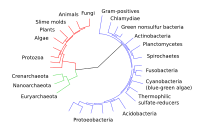
Photo from wikipedia
Genetic variation fuels Darwinian evolution, yet spontaneous mutation rates are maintained at low levels to ensure cellular viability. Low mutation rates preclude the exhaustive exploration of sequence space for protein… Click to show full abstract
Genetic variation fuels Darwinian evolution, yet spontaneous mutation rates are maintained at low levels to ensure cellular viability. Low mutation rates preclude the exhaustive exploration of sequence space for protein evolution and genome engineering applications, prompting scientists to develop methods for efficient and targeted diversification of nucleic acid sequences. Directed evolution of biomolecules relies upon the generation of unbiased genetic diversity to discover variants with desirable properties, whereas genome-engineering applications require selective modifications on a genomic scale with minimal off-targets. Here, we review the current toolkit of mutagenesis strategies employed in directed evolution and genome engineering. These state-of-the-art methods enable facile modifications and improvements of single genes, multicomponent pathways, and whole genomes for basic and applied research, while simultaneously paving the way for genome editing therapeutic interventions.
Journal Title: Current opinion in chemical biology
Year Published: 2017
Link to full text (if available)
Share on Social Media: Sign Up to like & get
recommendations!